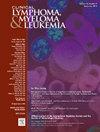对美国临床实践中使用阿西米尼治疗的慢性粒细胞白血病慢性期患者的治疗模式和临床结果的真实世界评估:CML-CP中阿昔米尼治疗结果的真实世界。
IF 2.7
4区 医学
Q2 HEMATOLOGY
引用次数: 0
摘要
背景:酪氨酸激酶抑制剂(TKIs)是治疗慢性髓性白血病慢性期(CML-CP)的主要药物。Asciminib是一种能与肉豆蔻酰口袋结合的ABL/BCR::ABL1抑制剂,最近在美国获批用于治疗曾接受过≥2种TKIs治疗或存在T315I突变的CML-CP患者。本研究描述了在美国临床实践中接受阿西替尼治疗的CML-CP患者的治疗模式和实际临床结果:从 Flatiron Health 数据库中获取了既往接受过≥2 种 TKIs 治疗后开始使用阿西米尼的 CML-CP 成年患者的电子健康记录数据,这些患者没有 T315I 突变。采用卡普兰-梅耶分析法评估了从开始使用阿西米尼(index date)起停止治疗的时间和分子反应(MR;分别为BCR::ABL≤0.1%和BCR::ABL1≤1%的时间):总体而言,97名患者(中位年龄:63岁,50.5%为女性,64.9%为白人)在既往接受过2次(47.4%)或3次(24.7%)或≥4次(27.8%)TKIs治疗后开始使用阿西米尼(asciminib)。总共有 85.7% 和 78.1% 的患者在指标发布后 12 周和 24 周仍在使用阿西米尼。在指数后进行了≥1次MR评估的患者中,31.3%(95%置信区间[CI]:21.6%,43.9%)和49.7%(95% CI:38.1%,62.6%)的患者在12周和24周前达到或保持BCR::ABL1≤0.1%,而51.3%(95% CI:40.1%,63.6%)和64.2%(95% CI:52.6%,75.6%)的患者在12周和24周前达到或保持BCR::ABL1≤1%:这项真实世界研究描述了美国既往接受过≥2种TKIs治疗后接受阿西替尼治疗的CML-CP患者的临床疗效,结果表明阿西替尼耐受性良好,疗效显著。这些结果与 ASCEMBL 试验的结果一致。本文章由计算机程序翻译,如有差异,请以英文原文为准。
Real-World Evaluation of Treatment Patterns and Clinical Outcomes among Patients With Chronic Myeloid Leukemia in Chronic Phase Treated With Asciminib in Clinical Practice in the United States
Background
Tyrosine kinase inhibitors (TKIs) are the mainstay treatment for chronic myeloid leukemia in chronic phase (CML-CP). Asciminib, an ABL/BCR::ABL1 inhibitor which binds to the myristoyl pocket, was recently approved in the US for patients with CML-CP previously treated with ≥2 TKIs or with the T315I mutation. This study described treatment patterns and real-world clinical outcomes among patients with CML-CP treated with asciminib in US clinical practice.
Methods
Electronic health record data from adult patients with CML-CP who initiated asciminib after ≥2 prior TKIs, without the T315I mutation, were obtained from the Flatiron Health database. Time-to-treatment discontinuation and molecular response (MR; time-to-BCR::ABL ≤0.1% and time-to-BCR::ABL1 ≤1%, separately) were evaluated from asciminib initiation (index date) using Kaplan–Meier analyses.
Results
Overall, 97 patients initiated asciminib (median age: 63 years, 50.5% female, 64.9% White) after either 2 (47.4%) or 3 (24.7%), or ≥4 (27.8%) prior TKIs. In total, 85.7% and 78.1% of patients remained on asciminib by 12- and 24-weeks postindex, respectively. Among patients with ≥1 MR assessment postindex, 31.3% (95% confidence interval [CI]: 21.6%, 43.9%) and 49.7% (95% CI: 38.1%, 62.6%) achieved or maintained BCR::ABL1 ≤0.1%, while 51.3% (95% CI: 40.1%, 63.6%) and 64.2% (95% CI: 52.6%, 75.6%) achieved or maintained BCR::ABL1 ≤1%, by 12- and 24-weeks, respectively.
Conclusions
Results of this real-world study describing clinical outcomes among patients with CML-CP treated with asciminib after ≥2 prior TKIs in the US demonstrated that asciminib was well-tolerated and effective. These findings were consistent with results from the ASCEMBL trial.
求助全文
通过发布文献求助,成功后即可免费获取论文全文。
去求助
来源期刊

Clinical Lymphoma, Myeloma & Leukemia
ONCOLOGY-HEMATOLOGY
CiteScore
2.70
自引率
3.70%
发文量
1606
审稿时长
26 days
期刊介绍:
Clinical Lymphoma, Myeloma & Leukemia is a peer-reviewed monthly journal that publishes original articles describing various aspects of clinical and translational research of lymphoma, myeloma and leukemia. Clinical Lymphoma, Myeloma & Leukemia is devoted to articles on detection, diagnosis, prevention, and treatment of lymphoma, myeloma, leukemia and related disorders including macroglobulinemia, amyloidosis, and plasma-cell dyscrasias. The main emphasis is on recent scientific developments in all areas related to lymphoma, myeloma and leukemia. Specific areas of interest include clinical research and mechanistic approaches; drug sensitivity and resistance; gene and antisense therapy; pathology, markers, and prognostic indicators; chemoprevention strategies; multimodality therapy; and integration of various approaches.
 求助内容:
求助内容: 应助结果提醒方式:
应助结果提醒方式:


